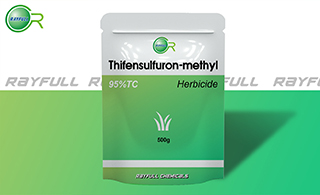THIFENSULFURON-METHYL
 аз·Ф»ЗВЎ аз·Ф»ЗВЎ
Introduction: Post-emergence, selective herbicide acting primarily through foliar uptake with little or no soil activity Uses Selective control of a wide range of annual weeds in cereals, maize and pasture. Treated cereals may experience a temporary inhibition of growth and colour changes in the leaves, but these have no ultimate effect on the yield.
Common name: Thifensulfuron-methyl
Another name: Harmony, Thifensulfuron methyl, Thiameturon-methyl, Pinnacle, Refine, Thifensulfuronmethyl, etc.
Chemical name: methyl 3-(4-methoxy-6-methyl-1,3,5-triazin-2-ylcarbamoylsulfamoyl)thiophene-2-carboxylate
Empirical formula: C12H13N5O6S2
Structural formula:

Mol. Weight: 387.39 g/mol
CAS No.: 79277-27-3
Specifications
Leading Thifensulfuron-methyl supplier
Thifensulfuron-methyl 75% WDG&WP
Thifensulfuron-methyl 95% TC
Packing:
BULK PACKING
Solid: 25kg/Bag, 25kg/Drum, 50kg/Drum etc.
SMALL PACKING
Solid: 1kg/Alu bag, 500g/Alu bag, 200g/Alu bag, 100g/Alu bag, 50g/Alu bag, 15g/Alu bag etc.
Customerized packing label
Thifensulfuron-methyl FAO standard
Professional registration
HAZARDS IDENTIFICATION
Hazard statement(s)
H400: Very toxic to aquatic life.
H410: Very toxic to aquatic life with long lasting effects.
Precautionary statement(s)
P273: Avoid release to the environment.
P391: Collect spillage.
P501: Dispose of contents/container to ...
Supplemental Hazard Statements: none
MAMMALIAN TOXICOLOGY
Acute toxicity: 1) Acute oral LD50 for rat: >5000 a.i.mg/kg. 2) Acute dermal LD50 for rat: >2000 a.i.mg/kg. 3) Inhalation LC50 (4 h) for rat: >5.03 a.i. mg/L. 4) Non-irritating to skin (rabbits). 5) Non-irritating to eyes (rabbits). 6) Not a skin sensitiser (guinea pigs).
NOEL: NOAEL (90 d) for rats is 100 mg/kg diet; (2 y) for rats is 500 mg/kg diet. NOAEL in reproduction (2 generation) in rats is 2500 mg/kg diet; teratogenicity in rats is 200 mg/kg daily. Non-mutagenic in the Ames and three other mutagenicity tests.
ADI: 0.02 mg/kg b.w./day [Rat, SF=100]
Classification:
Toxicity class WHO (a.i.): U (Unlikely to present an acute hazard)
US EPA Classification (formulation): IV (Caution - Not acutely toxic)
EC Risk Classification: N - Dangerous for the environment: R50, R53
ECOTOXICOLOGY
Effect on birds: low toxicity to birds, acute oral LD50 for Mallard ducks is >2510 a.i.mg/kg. Effect on fish: moderate toxicity to fish, acute 96 hour LC50 for Rainbow trout is >56.4 a.i.mg/L. Effect on aquatic invertebrates: moderate toxicity to aquatic invertebrates, acute 48 hour EC50 for Daphnia magna is 60.7 a.i.mg/L. Effect on algae: moderate toxicity to algae, acute 72 hour EC50 for Pseudokirchneriella subcapitata is >0.8 a.i.mg/L. Effect on honeybees: low-moderate toxicity to honeybees, contact acute 48 hour LD50 is >100 a.i.ҰМg/bee; oral acute 48 hour LD50 is >7.1 a.i.ҰМg/bee. Effect on earthworms: low toxicity to earthworms, acute 14 day LC50 for Eisenia foetida is >2000 a.i.mg/kg.
ENVIRONMENTAL FATE
Thifensulfuron methyl's production may result in its release to the environment through various waste streams; it's use as a herbicide will result in its direct release to the environment. If released to air, a vapor pressure of 1.28ЎБ10-10 mm Hg at 25 deg C indicates thifensulfuron methyl will exist solely in the particulate phase in the atmosphere. Particulate-phase thifensulfuron methyl will be removed from the atmosphere by wet or dry deposition. Thifensulfuron methyl may undergo direct photolysis in the environment based on a measured half-life of 15 hours for the structurally similar compound metsulfuron methyl. If released to soil, thifensulfuron methyl is expected to have very high to high mobility based upon Koc values ranging from 13-55. Volatilization from moist soil surfaces is not expected to be an important fate process based upon an estimated Henry's Law constant of 2.92ЎБ10-14 atm-cu m/mole. The pKa of thifensulfuron methyl is 4.0, indicating that the urea nitrogens in this compound will partially exist in anion form in the environment and anions generally do not adsorb more strongly to organic carbon and clay than their neutral counterparts. Thifensulfuron methyl is not expected to volatilize from dry soil surfaces based upon its vapor pressure. Thifensulfuron methyl is expected to biodegrade in soil based on half-lives of 1.6, 2, 25, and 37 days for this substance in different non-sterile soils compared with half-lives of 27, 25, 53, and 102 days in different sterile soils. The half-life for the microbial degradation of thifensulfuron methyl to thifensulfuron in soil has been reported as 2-3 days. If released into water, thifensulfuron methyl is not expected to adsorb to suspended solids and sediment based upon the range of Koc values. Thifensulfuron methyl is expected to biodegrade in water based on its behavior in soil. Volatilization from water surfaces is not expected to be an important fate process based upon this compound's estimated Henry's Law constant. A pKa of 4.0 indicates thifensulfuron methyl will exist almost entirely in the anion form at pH values of 5 to 9 and therefore volatilization from water surfaces is not expected to be an important fate process. An estimated BCF of 0.04 suggests bioconcentration in aquatic organisms is low. Thifensulfuron methyl is expected to undergo hydrolysis in the environment based on measured half-lives of 1.05, 7.07, 4.90, and 3.26 days at 25 deg C and pH 5, 6.5, 7.5, and 8.5, respectively. Occupational exposure to thifensulfuron methyl may occur through dermal contact with this compound at workplaces where thifensulfuron methyl is produced or used. (SRC)
Usage: Herbicidal activity of thifensulfuron-methyl reported by R. M. Ambach et al. (Proc. North Cent. Weed Control Conf., 1985, 39, 1220). Introduced by E. I. du Pont de Nemours and Co.; first approval in 1988. Manufacturers: DuPont; Fengle. Affects sensitive weeds through inhibition of the enzyme acetolactate synthase (ALS). Inhibition of ALS leads to the rapid cessation of cell division and subsequent growth processes in plants.
Application: Metsulfuron-methyl controls a wide range of annual and perennial broad-leaved weeds in wheat, barley, rice and oats, by either pre- or post-emergence application, at 4-7.5 g/ha post-emergence.
| 






